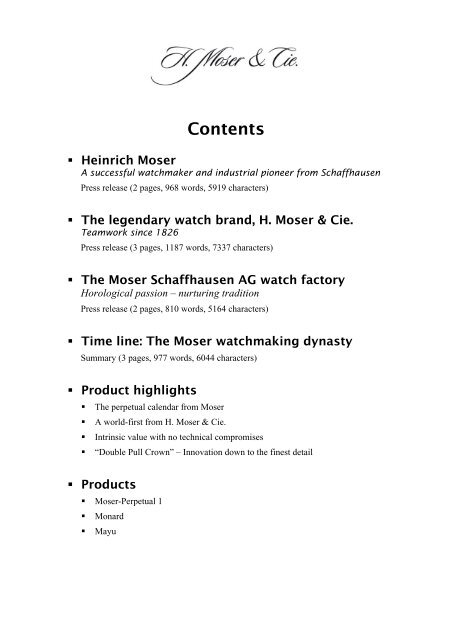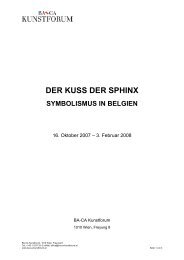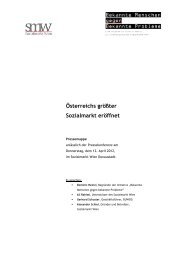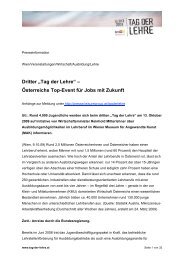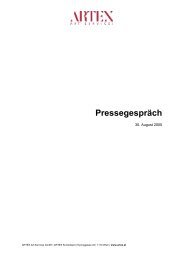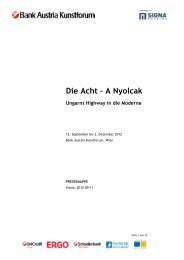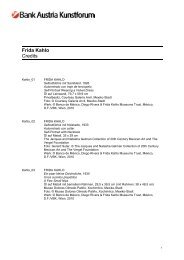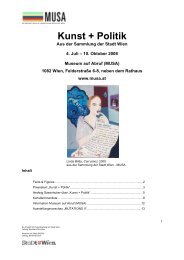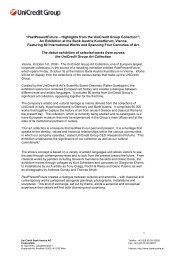Johann Heinrich Moser
Johann Heinrich Moser
Johann Heinrich Moser
Create successful ePaper yourself
Turn your PDF publications into a flip-book with our unique Google optimized e-Paper software.
Contents<br />
• <strong>Heinrich</strong> <strong>Moser</strong><br />
A successful watchmaker and industrial pioneer from Schaffhausen<br />
Press release (2 pages, 968 words, 5919 characters)<br />
• The legendary watch brand, H. <strong>Moser</strong> & Cie.<br />
Teamwork since 1826<br />
Press release (3 pages, 1187 words, 7337 characters)<br />
• The <strong>Moser</strong> Schaffhausen AG watch factory<br />
Horological passion – nurturing tradition<br />
Press release (2 pages, 810 words, 5164 characters)<br />
• Time line: The <strong>Moser</strong> watchmaking dynasty<br />
Summary (3 pages, 977 words, 6044 characters)<br />
• Product highlights<br />
• The perpetual calendar from <strong>Moser</strong><br />
• A world-first from H. <strong>Moser</strong> & Cie.<br />
• Intrinsic value with no technical compromises<br />
• “Double Pull Crown” – Innovation down to the finest detail<br />
• Products<br />
• <strong>Moser</strong>-Perpetual 1<br />
• Monard<br />
• Mayu
<strong>Heinrich</strong> <strong>Moser</strong><br />
A successful watchmaker and industrial pioneer from Schaffhausen
<strong>Heinrich</strong> <strong>Moser</strong> was born on 12 December 1805 and grew up in a Schaffhausen watchmaking<br />
family. Both his grandfather, <strong>Johann</strong>es <strong>Moser</strong> (1730-1820), and his father, Erhard <strong>Moser</strong><br />
(1760-1829), worked as town watchmakers in the town by the Rhine Falls. He learned the<br />
traditional watchmaker’s craft from his father between 1820 and 1824, and went on to<br />
broaden his knowledge after 1824 in the master watchmakers’ workshops in LeLocle<br />
(Switzerland). He had already come to recognize the restrictions imposed by the guild<br />
regulations, and he was a vehement opponent of these. At the same time, however, he did not<br />
ignore the quality-promoting aspects of these regulations, and he was even responsible for<br />
improving them. He rapidly gained respect as a skilled watchmaker, and he was able to start a<br />
successful small business to supply spare parts. It only took <strong>Moser</strong> about eighteen months to<br />
develop a reputation as an outstandingly talented specialist, and he received offers of work<br />
from Italy and Paris. From 1826, he was able to work for the first time on his own account for<br />
a German merchant, for whom he built clocks into cases and pieces of furniture. In November<br />
1827, the prospect of good business drew him to St. Petersburg in Russia, where in 1828 he<br />
opened H. <strong>Moser</strong> & Co. This marked the hour of inception of what would eventually grow<br />
into such a successful brand.<br />
<strong>Moser</strong>’s business flourished, which was certainly attributable to the painstaking care that he<br />
took throughout his life to ensure that the watches sold by him were supplied to a high quality<br />
standard. Not a single watch was allowed to pass over the shop counter unless it had been<br />
inspected personally by him or one of his representatives. In order to maintain this demand on<br />
superior quality, he established a watch factory in LeLocle in 1829, which produced watches<br />
exclusively for his businesses in Europe and Russia. The building that was home to the<br />
company exists to this day.<br />
The range of <strong>Moser</strong> watches grew to include 70 different calibres. In addition to the<br />
movements supplied by his own factory, he also purchased movements from such renowned<br />
companies as Urban Jürgensen or Jaeger-LeCoultre. The latter’s company archive lists him as<br />
a customer from 1860 onwards. From them he procured up to 64 different calibres, of which<br />
24 complications. The uncompromising quality of his watches gained him access as a supplier<br />
to the Imperial Russian Court, various royal houses and the armed forces. Within just a few<br />
years, he was selling watches to Japan, China and Persia, but also in the West in Paris and<br />
New York. Business continued to thrive, even in times of crisis, and <strong>Moser</strong>, who was by now<br />
a prosperous merchant and watch manufacturer, decided to return to Schaffhausen with his<br />
family at the end of 1848.<br />
From this point on, he would see his true life’s work as the transformation of Schaffhausen, a<br />
very quiet town in those days, into a lively and attractive industrial location, which also had<br />
room for a watch production facility. At the same time, he set about the construction of the<br />
magnificent Charlottenfels manor house for his family.<br />
In 1851 he completed the construction of a canal on the Rhine, which supplied the water to<br />
drive a turbine with an output of about 80 h.p. This was followed in 1853, in a joint venture<br />
with other personalities from Schaffhausen, by the establishment of the “Schweizerische<br />
Waggonfabrik bei Schaffhausen” (Swiss Wagonworks at Schaffhausen) and, in the same year,<br />
the establishment of the “Schweizerische Industriegesellschaft (SIG) Neuhausen” (Swiss
Industrial Company Neuhausen). <strong>Moser</strong> was a co-founder of the railway line Schaffhausen-<br />
Winterthur, also in 1853. Subsequent additional participations, company formations and cofinancing<br />
of company formations during this period can also be attributed to his tireless<br />
involvement.<br />
In the winter of 1863/64, he embarked on the construction of the largest Swiss dam over the<br />
Rhine, with the intention of supplying neighbouring industrial companies with inexpensive<br />
energy via a power transmission system. The turbines fed their energy into huge wire cable<br />
transmission systems, which then supplied it directly to a very wide range of production halls<br />
and workshops. This hydroelectric power station marked the dawn of the industrial age in<br />
Schaffhausen.<br />
In spite of the recognition which <strong>Moser</strong> now enjoyed in Schaffhausen, he was still not<br />
untouched by disappointments. He never got over the fact that his only son, Henri <strong>Moser</strong><br />
(1844-1923), showed no inclination to join his father’s watch company, let alone to succeed<br />
him at the helm.<br />
<strong>Heinrich</strong> <strong>Moser</strong> died on 23 October 1874. His second wife, Fanny, in accordance with his last<br />
will, inherited all his business interests. This made her one of the wealthiest women in<br />
Switzerland, although she had no desire to accept responsibility for what had by now become<br />
a global watch business. She sold the entire Russian operation to the local Managing Director,<br />
Mr Winterhalter, in 1877. The watch factory in LeLocle went to Paul Girard. It was stipulated<br />
in the contracts of sale that all successor companies would continue to operate in perpetuity<br />
under the registered brand names of H. <strong>Moser</strong> & Cie. or <strong>Heinrich</strong> <strong>Moser</strong> & Co.<br />
<strong>Heinrich</strong> <strong>Moser</strong> remains omnipresent to this day in Schaffhausen. The house in which he was<br />
born in the old town still exists, as does Charlottenfels. The modern Schaffhausen generating<br />
station today stands on the site of the historic dam on the Rhine. A large number of the<br />
businesses formed by him or with his help are still operating successfully. The residents of<br />
Schaffhausen have themselves honoured their famous fellow citizen with the eponymous<br />
<strong>Moser</strong>strasse, with a bronze bust in the <strong>Moser</strong>garten park that is used as a venue for events<br />
and, not least, by opening Charlottenfels to the public.
The legendary watch brand, H. <strong>Moser</strong> & Cie.<br />
Teamwork since 1826<br />
In 1826, towards the end of his apprenticeship and a period spent as a journeyman, <strong>Heinrich</strong><br />
<strong>Moser</strong> contemplated where and how he might build a successful future for himself. In fact, his<br />
aim was to introduce the manufactory method of working based on the principle of the<br />
division of labour in his home town of Schaffhausen, and to establish a small watch factory<br />
for this purpose. However, the Town Council at the time declined his proposal and awarded<br />
the honorary office of town watchmaker to another individual. <strong>Moser</strong> emigrated to St.<br />
Petersburg, in Russia, where he founded the trading company, “H. <strong>Moser</strong> & Co.”, at the end<br />
of 1828. From this company name, <strong>Moser</strong> also developed the company signature in cursive<br />
script, which was almost always supplemented by a medallion. Until about 1918, with rare<br />
exceptions, the company name in Cyrillic and/or Latin script, as well as the medallion,<br />
remained the standard signature on all the watches marketed by <strong>Moser</strong>’s watch companies,<br />
whether sourced from its own production or from outside suppliers.<br />
In 1829, he established a watch factory in LeLocle, which manufactured the pocket watches<br />
for his businesses in the European and Asiatic regions. By 1831, <strong>Moser</strong> was also able to open<br />
a branch in Moscow. Another astute business decision was the establishment of further<br />
branches in Nizhniy Novgorod and in Irbit – at the time the most important trade fair venues<br />
in Russia. The house of <strong>Moser</strong> thus had a presence in both of the Russian administrative<br />
centres, as well as at central trade fair venues.<br />
Little by little, <strong>Heinrich</strong> <strong>Moser</strong> overtook the old-established businesses and its newer<br />
competitors. Within just a few years, he was selling watches to Japan and China, Persia and<br />
Turkestan, Siberia and Kamchatka. By around 1845, he had become the undisputed market<br />
leader in the whole of Russia, dominating the watch trade there. He had even established<br />
business links with Paris.<br />
<strong>Moser</strong>’s Russian enterprises at the time employed around 50 persons. Among them were<br />
German, Swiss, Russian and Swedish watchmakers. The names of the Swiss watchmakers,<br />
<strong>Johann</strong> Jakob Bär, G. Ganther, <strong>Johann</strong> Winterhalter, Victor Guye, Palk and Schwab, as well<br />
as <strong>Moser</strong>’s son-in-law, Adolf Richard, are known from letters. An Italian, Bianco, is also<br />
mentioned. His most capable employee was undoubtedly J. Winterhalter, who subsequently<br />
took over <strong>Moser</strong>’s company in Russia.<br />
Even after <strong>Moser</strong> returned to Schaffhausen as a successful and wealthy businessman, he<br />
remained a passionate watchmaker at heart. He was aware from his training that, as far as<br />
pocket watches were concerned, case manufacture and quality often represented a weak point<br />
in the watch manufacturing process, and he opened a workshop with around 20 workers in<br />
Schaffhausen in 1853, where mainly silver watch cases were made. Three or four years later,<br />
he added a second workshop. In 1863, he equipped the workshops with completely new<br />
mechanical equipment, mostly to his own design, to facilitate case manufacture.
His only son, Henri <strong>Moser</strong> (1844-1923), showed little interest in the watch business, much to<br />
his father’s displeasure. As a result, they went their separate ways in 1870. On the death of<br />
<strong>Heinrich</strong> <strong>Moser</strong> in 1874, his second wife, Fanny, inherited all his business interests and the<br />
watch factory in LeLocle. She had no desire to accept the responsibility, however, and in<br />
1877 she sold the entire trading business to <strong>Johann</strong> Winterhalter and the watch factory in<br />
LeLocle to Paul Girard. In both transactions, she included conditions in the contracts to<br />
ensure that all the successor companies would continue to operate in perpetuity under the<br />
brand names of H. <strong>Moser</strong> & Cie. or <strong>Heinrich</strong> <strong>Moser</strong> & Co., in accordance with her husband’s<br />
instructions. All of the enterprises passed into other hands in this way. The only son of<br />
<strong>Heinrich</strong> <strong>Moser</strong>, Henri, had no male offspring, and the name <strong>Moser</strong> also died out in this<br />
family.<br />
In accordance with the contractual undertaking, the company name and the brand name<br />
remained unchanged, both in the global trade and in the watch factory at LeLocle. This<br />
situation continued until about 1917, when the Russian October revolution completely<br />
eliminated the watch market in the country that had been dominated by the Swiss<br />
watchmakers. The last of the Swiss Directors of the <strong>Moser</strong> company – Cornelius Winterhalter<br />
from about 1908 to 1918, and from 1910 to 1918 Octave Meylan – travelled back to<br />
Switzerland in early 1918, totally expropriated.<br />
Around 1920, the State-owned “Central Watch Repair Workshop” in Moscow was formed<br />
from the remains of the <strong>Moser</strong> watch businesses, and between 1927 and 1930 a start was<br />
made on the establishment of its own watch production. <strong>Moser</strong> watches continued to be<br />
regarded as a synonym for work of the highest quality for some considerable time afterwards.<br />
As late as 1966, the USSR presented one of its high-ranking military officers with an original<br />
<strong>Moser</strong> pocket watch in 18-carat gold, dating from the period before the expropriation, with a<br />
specially engraved dedication. This watch is now owned by <strong>Moser</strong> Schaffhausen AG as a<br />
special contemporaneous exhibit.<br />
Even after the take-over by the Girard family, the facility in LeLocle remained a production<br />
location for fine watches. It continued to adhere to <strong>Moser</strong>’s philosophy of supporting the<br />
business on several pillars – pocket watches and wristwatches – and of working closely with<br />
the best suppliers. However, the Cyrillic script on the inside of the dust cover that had<br />
frequently been used until then was now omitted from the signature.<br />
Information from 1953 points to an expansion in wristwatch production, and reference is<br />
made to a water-resistant 12-ligne watch and an 11 ½-ligne automatic watch, among others.<br />
H. <strong>Moser</strong> & Co. was also mentioned in 1973 as a manufacturer of precision lever escapement<br />
watches and special watches, predominantly in 18-carat gold and in cases set with precious<br />
stones.<br />
In 1979, the watch factory in LeLocle became part of the “Dixi-Mechanique” Group and<br />
traded as “Hy <strong>Moser</strong> & Cie.”.<br />
The original brand of the founder, “H. <strong>Moser</strong> & Cie.”, was once more registered<br />
internationally by Dr. Jürgen Lange in 2002. <strong>Moser</strong> Schaffhausen AG was launched jointly
with representatives of the <strong>Moser</strong> family. Today the great-grandson of <strong>Heinrich</strong> <strong>Moser</strong> –<br />
Roger Nicholas Balsiger – is Honorary Chairman of the Board of Directors. The Company is<br />
due to return to the international watch arena, in the autumn of 2005, to mark the bicentenary<br />
of <strong>Heinrich</strong> <strong>Moser</strong>’s birth.<br />
The new watches that have been developed by H. <strong>Moser</strong> & Cie. over the last three years add a<br />
hint of understatement to their traditionally classic/elegant appearance, and, entirely in<br />
keeping with the tradition of the establishment, utilize mechanical movements designed inhouse<br />
and executed to the highest quality standard. It goes without saying that these<br />
movements, which incorporate a cornucopia of technical innovations and offer high customer<br />
benefit, can only be found in watches from H. <strong>Moser</strong> & Cie.<br />
We have now come full circle, and, as the great-grandson expressed it so poignantly in an<br />
interview: “I find it very moving that we are now in a position to make <strong>Heinrich</strong> <strong>Moser</strong>’s<br />
return to Schaffhausen as a watchmaker possible 200 years after his birth.”
The <strong>Moser</strong> Schaffhausen AG watch factory<br />
Horological passion – nurturing tradition<br />
In September 2002, a new watch company was launched in Schaffhausen: <strong>Moser</strong><br />
Schaffhausen AG. The company was named after a famous watchmaker and businessman<br />
whose reputation extended well beyond the boundaries of Schaffhausen; his watches are<br />
legendary. He supplied them to the Russian Imperial Court and to China, Paris and New<br />
York.<br />
A small group of horological experts and investors associated with the great-grandson of<br />
<strong>Heinrich</strong> <strong>Moser</strong>, Roger Nicholas Balsiger, has made this reestablishment possible. They all<br />
share a passion for horology, business acumen and enthusiasm for beautiful watches. All of<br />
these are attributes which originally led <strong>Heinrich</strong> <strong>Moser</strong> to establish H. <strong>Moser</strong> & Cie. in the<br />
year 1826. The company name became a brand and, as such, a synonym for high-quality<br />
watches far beyond the boundaries of <strong>Moser</strong>’s home town of Schaffhausen.<br />
<strong>Moser</strong> had been preoccupied with the industrialization of Schaffhausen for his entire life. He<br />
had dreamed of opening a watch factory in his home town. 200 years after his birth, this<br />
dream has now become reality.<br />
It was also <strong>Moser</strong> who established the principle: If you want to make the best watches in the<br />
world, you must go to the best suppliers. For it is only there, at their very location, in their<br />
familiar surroundings, with their network, that these watchmakers are able to achieve true<br />
artistic skill.<br />
The present-day <strong>Moser</strong> Schaffhausen AG watch factory also adheres to this principle.<br />
Everything that has to do with the manufacture of watch parts, including the perfected<br />
assembly by hand and the building of the watches, is provided by the best subcontractors in<br />
the Swiss watch industry. This also extends to the most challenging parts of a mechanical<br />
watch, such as the escapement with the escape wheel and pallet, the escape pallets, the ellipse,<br />
or the authentic balance screws made of solid gold.<br />
The principal suppliers are situated in the Swiss Jura, close to the French border. The best<br />
watchmakers are to be found here in rural and uniquely beautiful surroundings. True works of<br />
art are created here from individual parts, which are fitted together into exclusive <strong>Moser</strong><br />
movements with workmanship of the purest form.<br />
<strong>Moser</strong> Schaffhausen AG, owner of the H. <strong>Moser</strong> & Cie. brand that is registered throughout<br />
the world, nevertheless maintains close links with Schaffhausen. The management offices are<br />
accommodated in a villa built about 100 years ago above the Rhine Falls. Administration,<br />
service department and workshops are only a few minutes away. In these premises The<br />
complete development process took place. With passion, expert knowledge and meticulous<br />
scientific precision, experienced watchmakers created mechanical movements which<br />
represent a cornucopia of innovations offering high customer benefit. Historical engineering<br />
was given a surprisingly new interpretation in a modern context, which accounts for the
exclusivity and the intrinsic value of the new movements. The traditions associated with the<br />
H. <strong>Moser</strong> & Cie. brand were maintained and integrated into the new watches, so that a high<br />
degree of recognition is assured.<br />
<strong>Moser</strong> Schaffhausen AG today – more than 175 years after it was originally founded –<br />
employs around 20 people and possesses extensive experience of the international watch<br />
trade. The company is represented by the Honorary Chairman of the Board of Directors, the<br />
great-grandson of <strong>Heinrich</strong> <strong>Moser</strong>, Roger Nicholas Balsiger.<br />
Roger N. Balsiger, in an interview in 2004:<br />
“My great-grandfather often complained bitterly in his letters that he had not been able to<br />
work as the town watchmaker in Schaffhausen, like his grandfather and father before him. I<br />
find it very moving that we are now in a position to make his return possible 200 years after<br />
his birth. With the establishment of <strong>Moser</strong> Schaffhausen AG, the last piece of a company<br />
which made its first appearance in the year 1826 falls into place.”<br />
Eric <strong>Moser</strong>, Chairman of the Board of Directors:<br />
“The special nature of the partnership with our suppliers, based on a spirit of cooperation at<br />
the highest technical and qualitative level and in the face of constantly new challenges, was<br />
one of the most memorable experiences during the entire development period.”<br />
Dr. Jürgen R. Lange, Vice Chairman and Managing Director:<br />
“A cornucopia of innovative new developments with high customer benefit characterizes the<br />
mechanical movements developed in-house and used exclusively for H. <strong>Moser</strong> & Cie.”<br />
Michel Staub, Member of the Board of Directors and the Executive Board:<br />
“A truly exciting feature of the <strong>Moser</strong> watches of the new era is their classic elegance,<br />
combined with a alluring penchant for understatement.”<br />
Ulrich Blauw, Member of the Board of Directors:<br />
“Solid craftsmanship and horological passion have resulted in watches whose appeal lies in<br />
their unobtrusive outward appearance and which make the complexity of their internal<br />
workings accessible to connoisseurs at a second glance.”<br />
Dr. Christoph Born, Member of the Board of Directors:<br />
“A team whose enthusiasm for creating something special is absolutely infectious.”
Time line<br />
The <strong>Moser</strong> watchmaking dynasty<br />
1730 <strong>Johann</strong>es <strong>Moser</strong>, grandfather of <strong>Heinrich</strong> <strong>Moser</strong>, is born in Schaffhausen. After an<br />
apprenticeship as a watchmaker, he assumes the hereditary and honorary position of<br />
town watchmaker. He later becomes a Cantonal Councillor.<br />
1760 Erhard <strong>Moser</strong>, father of <strong>Heinrich</strong> <strong>Moser</strong>, is born in Schaffhausen. He inherits the<br />
position of town watchmaker from his father and is himself a member of the Cantonal<br />
Council.<br />
1805 <strong>Johann</strong> <strong>Heinrich</strong> <strong>Moser</strong> is born on 12 December. He learns the traditional<br />
watchmaker’s craft from his father between 1820 and 1824.<br />
1824 <strong>Heinrich</strong> <strong>Moser</strong>’s travels take him to Le Locle (Switzerland) and its master<br />
watchmakers’ workshops. He rapidly gains respect as a skilled watchmaker, and he is<br />
able to start a successful small business to supply spare parts. It only takes <strong>Moser</strong><br />
about eighteen months to develop a reputation as an outstandingly talented specialist,<br />
and he receives offers of work from Italy and Paris.<br />
1826 <strong>Moser</strong> works for the first time on his own account by building clocks into cases and<br />
pieces of furniture.<br />
1827 The prospect of good business draws <strong>Moser</strong> to St. Petersburg in Russia. After a<br />
hazardous journey by horse and carriage and by ship, his money eventually dwindles<br />
away. He starts work as a watchmaker in the local workshops.<br />
1828 The trading company, H. <strong>Moser</strong> & Co., is founded in St. Petersburg. This marks the<br />
hour of inception of what would eventually grow into such a successful brand.<br />
<strong>Moser</strong>’s business flourishes, which can certainly be attributed to the fact that the<br />
watches sold by him are supplied only in high quality. Not a single watch is allowed<br />
to pass over the shop counter unless it has been inspected personally by him or one of<br />
his representatives.<br />
1829 In order to maintain this demand on superior quality, he establishes a watch factory in<br />
Le Locle to produce watches exclusively for his businesses in Europe and Russia.<br />
1848 <strong>Moser</strong>, by now a wealthy merchant and watch manufacturer, decides to return to<br />
Schaffhausen with his family. From this point on, he sees his true life’s work as the<br />
transformation of Schaffhausen, a very quiet town in those days, into a lively and<br />
attractive industrial location. At the same time, he also builds the magnificent<br />
Charlottenfels manor house for his family.
1851 <strong>Moser</strong> completes the construction of a canal on the Rhine, the water from which<br />
drives a turbine with an output of about 80 h.p.<br />
1853 In a joint venture with other Schaffhausen personalities, <strong>Moser</strong> establishes the<br />
“Schweizerische Waggonfabrik bei Schaffhausen” (Swiss Wagonworks at<br />
Schaffhausen) and, in the same year, the “Schweizerische Industriegesellschaft (SIG)<br />
Neuhausen” (Swiss Industrial Company Neuhausen). <strong>Moser</strong> is a co-founder of the<br />
Schaffhausen-Winterthur railway line, also in 1853. He also opens a workshop for the<br />
manufacture of watch cases in Schaffhausen.<br />
1860 The company archive of Jaeger-LeCoultre from this year lists <strong>Heinrich</strong> <strong>Moser</strong> as a<br />
customer. Over time, he procures up to 64 different calibres, including 24<br />
complications, from them. The uncompromising quality of his watches gains him<br />
access as a supplier to the Imperial Russian Court, various royal houses and the armed<br />
forces. Within just a few years, he is selling watches to Japan, China and Persia, but<br />
also in the Western world e.g. in Paris and New York.<br />
1863/64 <strong>Heinrich</strong> <strong>Moser</strong> embarks on the construction of the largest Swiss dam over the<br />
Rhine, to supply neighbouring industrial companies with inexpensive energy via a<br />
power transmission system. This hydroelectric power station marks the dawn of the<br />
industrial age in Schaffhausen.<br />
1868 <strong>Moser</strong> supports Aristo Jones in the foundation of his International Watch Company<br />
(IWC) by providing premises and energy to drive the machines.<br />
1874 <strong>Heinrich</strong> <strong>Moser</strong> dies on 23 October. His last will names his second wife, Fanny, as the<br />
heiress of all his business interests.<br />
1877 Fanny sells the entire Russian operation to the local Managing Director, Mr<br />
Winterhalter. The watch factory in Le Locle goes to Paul Girard. The contracts of sale<br />
stipulate that all successor companies must continue to operate in perpetuity under the<br />
registered brand names of H. <strong>Moser</strong> & Cie. or <strong>Heinrich</strong> <strong>Moser</strong> & Co.<br />
1917 The Russian October revolution completely eliminates the private watch market in the<br />
country that is dominated by the Swiss watchmakers. The last of the Swiss Directors<br />
of the <strong>Moser</strong> company travel back to Switzerland in early 1918 totally expropriated.<br />
The business in Le Locle is spared from these political upheavals and continues to<br />
operate unaffected. An attempt is made to compensate for the loss of the Russian<br />
markets through increased exports to other countries.<br />
1920 The State-owned “Central Watch Repair Workshop” in Moscow is formed from the<br />
remains of the <strong>Moser</strong> watch businesses.<br />
1953 Wristwatch production in Le Locle is expanded, and the proportion of pocket watches<br />
produced steadily decreases. Some of the watches also bear the name “Henry <strong>Moser</strong>”,<br />
although this is in breach of the 1877 agreements.
1973 H. <strong>Moser</strong> & Co. is mentioned as a manufacturer of precision lever escapement<br />
watches and special watches, predominantly in 18-carat gold and in cases set with<br />
precious stones. The quartz watch crisis that is widespread throughout the Swiss<br />
watch industry also affects the business in Le Locle.<br />
1979 The watch factory in Le Locle becomes part of the “Dixi-Mechanique” Group and<br />
trades as “H y <strong>Moser</strong> & Cie.”.<br />
2002 The original brand of the founder, “H. <strong>Moser</strong> & Cie.”, is registered once more<br />
internationally by Dr. Jürgen Lange. <strong>Moser</strong> Schaffhausen AG is launched jointly with<br />
representatives of the <strong>Moser</strong> family. Today the great-grandson of <strong>Heinrich</strong> <strong>Moser</strong> –<br />
Roger Nicholas Balsiger – is Honorary Chairman of the Board of Directors.<br />
2005 To mark the bicentenary of <strong>Heinrich</strong> <strong>Moser</strong>’s birth, the successor company, <strong>Moser</strong><br />
Schaffhausen AG, is once again launching a range of watches on the international<br />
watch arena under the H. <strong>Moser</strong> & Cie. brand that are faithful to the legacy of the<br />
founding father.
The perpetual calendar from <strong>Moser</strong><br />
A technical delicacy of a particular kind<br />
The master watchmakers at <strong>Moser</strong> have completely redeveloped the perpetual calendar, which<br />
indicates the correct date depending on the length of each month. This classic complication is<br />
combined for the first time with a neat, restrained and elegant dial. The date in the MOSER-<br />
PERPETUAL 1 is accordingly displayed in an entirely traditional way as a number in a large<br />
dial window at 3 o’clock.<br />
The perpetual calendar from <strong>Moser</strong> is the only one in the world to feature a “Flash Calendar”<br />
display. This means that the date on the watch jumps directly from the end of one month to<br />
the start of the following month, without any intermediate stages. No incorrect date is<br />
displayed during the switching phase; for example, from 28 February to 1 March, “28” is<br />
followed directly by “1” in the window on the dial.<br />
The perpetual calendar can naturally be adjusted both forwards and backwards. The month is<br />
indicated with a small centre hand by utilizing the hour indices. The leap year indication,<br />
which can be adjusted via a pin pusher, is present on the back of the HMC341 movement.
A world-first from H. <strong>Moser</strong> & Cie.<br />
The world’s first-ever interchangeable escapement module in a wristwatch<br />
Longevity and ease of servicing are features which the development engineers at <strong>Moser</strong> have<br />
placed right at the top of their specification. They have accordingly pondered about how the<br />
mechanical heart, the pacemaker of a watch, might be improved. They started by replacing the<br />
index system on the balance wheel used for timing with traditional weight compensation<br />
screws made of solid gold on the balance wheel ring. No easy feat, considering that the task at<br />
hand was to manufacture screws with a precision thread of 0.35 mm in diameter. However,<br />
the resulting advantage was worth the effort: the balance wheel beats more evenly, the<br />
escapement is less susceptible to shocks, and the positional dependency of the watch is<br />
reduced.<br />
If a watch movement is cleaned during servicing, in order to remove the abrasion products<br />
caused by friction, all the parts must be dismantled, washed, reassembled and oiled. This also<br />
applies to the component parts of the escapement, which must then be retimed from the<br />
beginning: this is a meticulous and, above all, time-consuming procedure. Here, too, a novel<br />
solution was found at <strong>Moser</strong>. The complete escapement assembly is mounted on a separate<br />
plate, for the first time in a wristwatch, and is only connected to the rest of the movement via<br />
the escape wheel drive. This means that the assembly is completely interchangeable by<br />
releasing only two screws. It is removed in the course of servicing and replaced by an<br />
equivalent escapement assembly as a service exchange item. The assembly is then cleaned<br />
and retimed, but only by specialists at <strong>Moser</strong>. The time spent in the service department by a<br />
<strong>Moser</strong> watch can be reduced considerably in this way, and the accuracy of the timing can be<br />
increased.
Intrinsic value with no technical compromises<br />
The escape wheel and pallets of the latest watches from H. <strong>Moser</strong> & Cie are<br />
made of solid gold<br />
Wheel trains made of gold, which were hardened by extremely intricate hammering, can be<br />
found in historic watches in the highest quality segment, a feature also shared by a small<br />
number of rare <strong>Moser</strong> pocket watches dating from the 19th century.<br />
The watchmakers at <strong>Moser</strong> are reviving this tradition and are equipping the novel,<br />
interchangeable escapement assembly in all <strong>Moser</strong> watches of the new era with a gold pallet<br />
and a gold escape wheel. This is an innovation without precedent in the industry. The decision<br />
to proceed was an easy one for the watchmakers: it was justified both by the high intrinsic<br />
value of solid gold and by the absolute, high precision with which these parts are<br />
manufactured. This precision benefits the longevity and constancy of the escapement<br />
assembly. The surfaces of the escape wheel, which are exposed to friction with the ruby<br />
pallets, are executed with a previously unachieved mirror-finish. They exhibit a surface<br />
roughness of less than 50 nanometers, which is equivalent to 50 millionths of a millimetre.<br />
The friction between the component parts is minimized, and the service life is increased in<br />
this way. The required hardness of the gold is achieved by a patented, high-technology<br />
process and itself contributes to the resistance to wear.
“Double Pull Crown” – Innovation down to the<br />
finest detail<br />
The mechanism of the winding crown from H. <strong>Moser</strong> & Cie.<br />
The watch development engineers at <strong>Moser</strong> are challenging even quite traditional functional<br />
processes of the wristwatch. This also applies to the various functions of the winding crown.<br />
The mechanism of the crown in watches from <strong>Moser</strong> also has three functions, which are<br />
selected by different positions. Position 1 is used for winding the watch, Position 2 for setting<br />
the date, and the hands can be adjusted in Position 3 – so far entirely traditional. <strong>Moser</strong> has<br />
developed the “Double Pull Crown” mechanism, to permit the various positions of the<br />
winding crown to be selected exactly. This ensures that, when the crown is pulled out fully,<br />
only Position 2 for setting the date is engaged. Only by releasing the crown briefly, and by<br />
then pulling it out fully for a second time, is it possible to access Position 3, which adjusts the<br />
hands – irritation eliminated. A final press on the crown returns it to winding position 1. The<br />
tiresome searching for the central position of the winding crown for its adjustment function is<br />
now a thing of the past in all <strong>Moser</strong> watches with a date indicator. This is a new function with<br />
high exclusivity and considerable customer benefit.
Ref. 341.501<br />
The MOSER-PERPETUAL 1, a watch with a perpetual calendar, the like of which the world<br />
has never previously seen. The unique arrangement of the displays provides classic clarity in spite<br />
of the complicated internal workings. This first watch of the new generation is equipped with the<br />
<strong>Moser</strong> dual spring barrel and has a power reserve of at least seven days. <strong>Moser</strong> is the first to use<br />
the interchangeable escapement module for superb ease of service. Another exclusive and unique<br />
feature is the execution of the escape wheel and pallets in hardened solid gold.<br />
The MOSER Cal. HMC341 MOVEMENT is a hand-wound movement with a perpetual calendar,<br />
and with the facility for forwards and backwards adjustment. The “Flash Calendar” display,<br />
which switches directly from the end of the month to the first day of the following month, without<br />
indicating any incorrect dates, is protected by a patent application. The only evidence of the<br />
perpetual calendar on the dial is the large date and the highly restrained design of the month hand,<br />
which utilizes the twelve hour indices. The date can be adjusted with the patented “Double Pull<br />
Crown” mechanism, which ensures reliable setting of the crown to the correct position.<br />
A three-part case of round design in rose gold, white gold or platinum with a discreetly convex<br />
sapphire glass and a sapphire glass see-through back, a crocodile leather strap, and a clasp in solid<br />
gold or platinum with the <strong>Moser</strong> logo engraved in the niello technique.
Ref. 342.502<br />
The MONARD from <strong>Moser</strong>. A watch in the classically elegant style with centre second and a<br />
large date. <strong>Moser</strong> dual spring barrel for a power reserve of at least 7 days and a reserve display on<br />
the movement side visible through the sapphire glass see-through back. The use of an<br />
interchangeable escapement module is a <strong>Moser</strong> world-first and satisfies the highest demands for<br />
function and ease of service. A further exclusive feature is the patented design of the escape<br />
wheel and pallets in hardened solid gold.<br />
The MOSER Cal. HMC342 MOVEMENT is a hand-wound movement with true bevel wheels for<br />
smooth, low-wear operation and with <strong>Moser</strong> teeth designed for optimal efficiency in the entire<br />
wheel train. The date is adjusted via the patented “Double Pull Crown” mechanism, which<br />
ensures reliable setting of the crown to the correct position. Also typical of <strong>Moser</strong> is the<br />
arrangement of the fourth and the third wheels under a common bridge. Screwed gold chatons and<br />
<strong>Moser</strong> ground stripes visually underscore the inherent value of this movement.<br />
A three-part case in rose gold, white gold or platinum with a discreetly convex sapphire glass and<br />
a sapphire glass see-through back. A crocodile leather strap and a clasp in solid gold or platinum<br />
with the <strong>Moser</strong> logo engraved in the niello technique.
Ref. 321.503<br />
The MAYU from <strong>Moser</strong>. An elegant watch with a certain hint of understatement. It is<br />
characterized by a distinctively classic design, only 9.3 mm thin, and features the rare, large<br />
pocket watch seconds display. A power reserve of 80 hours ensures that the watch will continue<br />
to operate for three days without winding. The first-ever interchangeable escapement module,<br />
introduced by <strong>Moser</strong> for longevity and ease of service, makes for high exclusivity. The execution<br />
of the escape wheel and pallets in hardened solid gold with functionally optimized surfaces is also<br />
a world-first.<br />
The MOSER Cal. HMC321 MOVEMENT is a hand-wound movement with a diameter of 32 mm<br />
and <strong>Moser</strong> teeth in the entire wheel train. True bevel wheels in the winding system ensure<br />
smooth, low-wear operation – a world rarity in wristwatches. Also traditional for <strong>Moser</strong> is the<br />
arrangement of the fourth and the third wheels under a common bridge. Cut-off and polished<br />
edges, a sun-pattern ground finish on the plate and bridges, and the <strong>Moser</strong> ground stripes<br />
emphasize the inherent value of this movement.<br />
A three-part case, available in yellow gold, white gold or platinum with a discreetly convex<br />
sapphire glass and a sapphire glass see-through back, a crocodile leather strap, and a clasp in solid<br />
gold or platinum with the <strong>Moser</strong> logo engraved in the niello technique.


